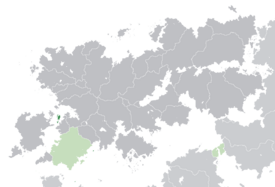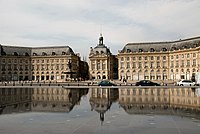Sasora
This article is incomplete because it is pending further input from participants, or it is a work-in-progress by one author. Please comment on this article's talk page to share your input, comments and questions. Note: To contribute to this article, you may need to seek help from the author(s) of this page. |
Island of Sasora | |
|---|---|
 Location of Sasora (dark green) – in Latium (light green) – in Belisaria (dark grey) | |
| Status | Caesaerian province |
| Capital and largest settlement | Caetot |
| Official languages | |
Recognized languages | |
| Demonym(s) | Sasoran |
| Government | Caesarian province |
• Emperor | Constantine XX |
| The Duke of Ostia | |
• Speaker of Assembly | Azelma Pelana |
| Legislature | Island Assembly |
| Establishment | |
• Norse kingdom | 700 |
• Gelonian integration | 1229 |
• Latin conquest | 1580 |
• Current Imperial Charter | 9 May 1979 |
| Currency | Solidus ($) (LAS) |
| Time zone | UTC (±0 WBT) |
• Summer (DST) | UTC+1 (Latin Summer Time) |
| Date format | dd/mm/yyyy;(AD) |
| Driving side | left |
| Calling code | +4 |
| Internet TLD | .la |
Sasora, officially the Island of Sasora (Latin: Insula Sasorae; Lugense: Enez Lugenez; Sasoran: Îles dé Sasore) is a Caesarian province of Latium, located north of the Angusta Strait.
Sasora was first inhabited by the XXXX, a Celtic tribe which later became part of the ancient Latin province of Gelonia in the late 2nd century BCE, under whose domain it remained until an 8th century Viking incursion. The Kingdom of the Isles was established by Norse invaders, ruling over Sasora and surrounding islands until being absorbed into Gelonia and the Audonian Empire by 1250. The island became a territory of the first Kingdom of Gelonia in the 13th century, though was eventually surrendered to the Monarchy of Latium, after a brief spell under the dominion of Adrianople, in 1632. It has remained a Latin territory since, and was reorganized into a Caesarian province in 1950 following the Gelonian War of Independence, with further autonomy granted in 1979. A failed independence referendum was held in 1975, due to protocols of the Brennia Agreement.
The island is largely self-governing, with its own legislature, and legal and judicial systems. The Count Palatine is the personal representative of the Emperor, serving as the island's governor. Sasora is a party to the Belisarian Community through Latium. Centuries of Latin influence have developed into a unique Sasoran culture, though Latin is spoken in unison with Sasoran.
Etymology
The Gelonian name for the island is Lugenez. It is a combination of the Gelonian words "Enez", meaning island, and "lugenez" meaning fog or cloudy. This name is first attested in 2rd century BC writings. Since its discovery by Latins, the island has been referred to as Sasora. This roughly translates to "rocky coast" from the Latin from "saxosus" and "ora".
History
Antiquity
Middle ages
Modern history
Politics
Sasaora's unicamerial legislature is the Island Assembly. It consists of 79 members, of which 60 are deputies elected by single-member constituencies and 19 mayors representing municipalities. The 60 deputies are elected to four-year terms, the most recent election happening on 19 June 2017, while mayors are elected to varying terms beginning at various times, no term lasting longer than six years. There are also three non-voting members of the legislature: the Count Palatine of Sasora, the Attorney General, and the Speaker of the Assembly.
The Government of Sasora consists of the ten-member Island Council. Among the councillors are the Count Palatine, who leads the council, the Attorney General, and 8 other ministers. The Count Palatine is, nominally, the leader of the Sasoran civil service, but some government functions are carried out by local governments.
As a Caesarian province, Sasora is autonomous and self-governing, with its own legal and administrative systems. Sasora operates under an Imperial charter, which serves as its constitutional framework. It was first introduced in 1950 and later revised in 1979 to provide additional legal competencies, including recognition of Sasoran customary law. Though not part of the Sasoran government, the Committee of Affairs for Caesarian Provinces continually plays a key role in local government and supervision.
The Count Palatine is the Emperor's chief representative in Sasora. The Count Palatine holds civil authority of the province and is the main point of contact between the province and the central government. He nominally serves as the leader of the civil service. Marius Ostia, Duke of Ostia has served as Count Palatine since January 2018.
Administrative divisions
Sasora is divided into six dioceses with each having its own regional committee. Dioceses are subdivided into local council areas, of which there are 50. Council areas are key in providing government services throughout the island, in some cases with the central provincial government acting as a go between the councils and central government in Castellum. The council areas provide local needs, including infrastructure and general upkeep, waste collection, and a number of administrative functions for the province's government.
Legal system
Law of Sasora has been influenced by several different traditions, most notably customary Sasoran law, Latin law, and Arthuristan common law. Its legal system can be described as mixed. The main working language of the judiciary is Latin, but Sasoran is a co-official language.
The province's principal court is are district courts, with appeals sent to the Sasoran Court of Assidere. The ultimate court of last resort is the Imperial Judicial Board and the Monarch. Judges are appointed to ten year terms by the Monarch.
Geography
Sasora is an located in the north Angusta Strait, Xkm from Arthurista and Xkm from Gelonia. It is an archipelago consisting of numerous islands, seven of which are inhabited. The main island of Sasora is Xkm2 and is home to the the largest settlements in the province, including the capital Caetot. The province's placement at the entrance of the Angusta Strait places it in a strategic shipping lane.
Climate
Sasora can be classified as a temperate oceanic climate, with long, mild to hot summers and average temperature of 21.8 °C (71.24 °F). Winters are short on average and generally cool, with an average temperature of 7.5 °C (45.5 °F). Rain is common throughout the year, with snow occurring annually, though heavy, sustained snowfall is rare. Extreme temperatures are possible, reaching beyond 25 °C (77.0 °F) at least 28 to 35 days in the summer.
Economy
Demographics
Languages
Latin and Sasoran are the two official languages of Sasora, recognized by both the 1979 Imperial charter and the local government. Arthuristan and Lugense are recognized minority languages, but hold no official status as working languages within the government.
Sasoran is a Latinic language descended from Gaelo-Latin dialects spoken on the island in antiquity. It has been heavily influenced by ancient Keulandic due in part to its Viking history and the medieval Kingdom of the Isles. Sasoran borrows extensively from Latin and Norse. At least 88% of residents are fluent in Sasoran, while 95% estimated to be conversant in both Latin and Sasoran. Arthuristan is widely taught in schools, and is the third most widely spoken language, followed by Audonian, and Gelonian. It is considered one of the most multi-lingual places in Latium.
Religion
Christianity is the majority religion of Sasora, with various forms of Protestantism as the most followed Christian faiths, followed by Catholicism the most widely followed minority faith. The Evangelical-Episcopal Church of Sasora is the largest religion in Sasora by following, boasting a majority of 58.8% of residents among its membership. Along with its sizeable Catholic population of 22.6%, there are numerous Lutheran and Reformed sects present throughout Sasora.




